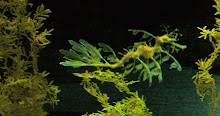Hi. Welcome (back) to Weirdbeautiful. Link-of-the-day today is this article claiming that regular meditation alters the structure of the brain-
http://well.blogs.nytimes.com/2011/01/28/how-meditation-may-change-the-brain/
Saturday 29 January 2011
Wednesday 26 January 2011
Genius, Quotes and... Prawns
.

The shrimp Heterocarpus ensifer.
Hi. Welcome (back) to Weirdbeautiful. At the moment, there is no shortage of scientific breakthroughs in the news. Perhaps one of the most exciting is this story about the potential use of chitosan: a substance found in the shells of prawns and crabs: to rebuild damaged human nerves and ultimately, it is hoped, offer a cure for certain paralyzed patients-
http://www.sciencedaily.com/releases/2009/06/090616164002.htm

The structure of Chitosan
----------------------------------------------------------------------------------
"The secret of genius is to carry the spirit of the child into old age."
- Aldous Huxley
----------------------------------------------------------------------------------
One of my long-term preoccupations is with the human mind: a truly weird and beautiful thing. Consequently, I was very interested to read this article on genius, which was recently brought to my attention-
http://www.prometheussociety.org/articles/Outsiders.html
Essentially, it highlights the extreme separation of people of extremely high intelligence from the general population. IQ tests are-indisputably-unreliable and often flawed in many regards, but that clearly does not mean that they have no use. I am not sure that I fully endorse the article and its conclusions, but they are certainly thought-provoking.

In her excellent biography of Rosalin Franklin,
"Rosalind Franklin: The Dark Lady of DNA" ,
,
the science writer Brenda Maddox talks about the "otherness" of working in research science- the sense of separateness from society that can arise when one's work is beyond the ken of "ordinary" people and the loneliness of a life where one toils on abstract problems that perhaps -what?- 80%? 90% ? 95%? of the population cannot really grasp in outline, let alone in detail. She mentions it in the context of Franklin's struggles in her mid career and her sense of isolation. It seems to me that this overlaps with a lot of the ideas in the "outsiders" article.
The article also explains the reason that childhood prodigies are often quoted as having apparently astronomical IQ scores that later "regress towards the mean" as they age. Essentially, this is an inherent problem with the measurement of childhood intelligence and not any indication of brain decline.
Many thanks to Nurit for the genius article link.

The shrimp Heterocarpus ensifer.
Hi. Welcome (back) to Weirdbeautiful. At the moment, there is no shortage of scientific breakthroughs in the news. Perhaps one of the most exciting is this story about the potential use of chitosan: a substance found in the shells of prawns and crabs: to rebuild damaged human nerves and ultimately, it is hoped, offer a cure for certain paralyzed patients-
http://www.sciencedaily.com/releases/2009/06/090616164002.htm

The structure of Chitosan
----------------------------------------------------------------------------------
"The secret of genius is to carry the spirit of the child into old age."
- Aldous Huxley
----------------------------------------------------------------------------------
One of my long-term preoccupations is with the human mind: a truly weird and beautiful thing. Consequently, I was very interested to read this article on genius, which was recently brought to my attention-
http://www.prometheussociety.org/articles/Outsiders.html
Essentially, it highlights the extreme separation of people of extremely high intelligence from the general population. IQ tests are-indisputably-unreliable and often flawed in many regards, but that clearly does not mean that they have no use. I am not sure that I fully endorse the article and its conclusions, but they are certainly thought-provoking.

In her excellent biography of Rosalin Franklin,
"Rosalind Franklin: The Dark Lady of DNA"
the science writer Brenda Maddox talks about the "otherness" of working in research science- the sense of separateness from society that can arise when one's work is beyond the ken of "ordinary" people and the loneliness of a life where one toils on abstract problems that perhaps -what?- 80%? 90% ? 95%? of the population cannot really grasp in outline, let alone in detail. She mentions it in the context of Franklin's struggles in her mid career and her sense of isolation. It seems to me that this overlaps with a lot of the ideas in the "outsiders" article.
The article also explains the reason that childhood prodigies are often quoted as having apparently astronomical IQ scores that later "regress towards the mean" as they age. Essentially, this is an inherent problem with the measurement of childhood intelligence and not any indication of brain decline.
Many thanks to Nurit for the genius article link.
Labels:
Brenda Maddox,
Crustacea,
Cure for Paralysis,
geniuses,
IQ tests,
Outsider,
Prawns,
Rosalind Franklin
Saturday 22 January 2011
Image of the day- Panda

Giant panda cub - Image by Colegota (this picture has a creative commons 2.5 licence- for details, click [here])
There are a lot more pictures of panda cubs and information about them here-
http://www.galenfrysinger.com/panda_nursery_china.htm
Thursday 20 January 2011
Quote of the Week- Albert Einstein on the key to his thoughts

“When I examine myself and my methods of thought, I come to the conclusion that the gift of fantasy has meant more to me than any talent for abstract, positive thinking.”
-Albert Einstein
Key picture by Evan Amos.
Saturday 15 January 2011
Weird-creature Ping-pong tree sponge.
Weird creature of the day is the so-called "ping-pong tree sponge":
Chlondrocladia lampadiglobus, which was featured in the November/December Issue of American Scientist, but, according to wikipedia, discovered back in 2006, by Jean Vacelet. This bizarre creature is carnivorous, as are all the sponges in the genus Chlondrocladia, which is a very unusual adaptation in sponges, which are generally filter feeders. In a recent paper, Prof. Vacelet and colleague Michelle Kelly, suggested that this carnivorous feeding habit had evolved in this group of deep sea sponges in response to the "difficult conditions of [their] deep sea environment".
http://madethere.files.wordpress.com/2008/10/mbari_chondrocladia_72.jpg
The American Scientist article was called "An Empire Lacking Food" ( volume 98 number 6, pages 470-477). There is a blog-post with a photo of the pingpong tree sponge on the American Scientist website [here], although there is an error in the post (bioluminescence is very common in sea creatures, especially, deep sea ones, but it is not really "the norm", as the article says).
Chlondrocladia lampadiglobus, which was featured in the November/December Issue of American Scientist, but, according to wikipedia, discovered back in 2006, by Jean Vacelet. This bizarre creature is carnivorous, as are all the sponges in the genus Chlondrocladia, which is a very unusual adaptation in sponges, which are generally filter feeders. In a recent paper, Prof. Vacelet and colleague Michelle Kelly, suggested that this carnivorous feeding habit had evolved in this group of deep sea sponges in response to the "difficult conditions of [their] deep sea environment".
http://madethere.files.wordpress.com/2008/10/mbari_chondrocladia_72.jpg
The American Scientist article was called "An Empire Lacking Food" ( volume 98 number 6, pages 470-477). There is a blog-post with a photo of the pingpong tree sponge on the American Scientist website [here], although there is an error in the post (bioluminescence is very common in sea creatures, especially, deep sea ones, but it is not really "the norm", as the article says).
Saturday 8 January 2011
Link of the day- Baby Bats rescued from Australian floods

Picture by Luke Marsden/Newspix / Rex Features. For full article and more pictures, see The Sun newspaper.
If you thought Bats weren't cute, think again-
http://www.thesun.co.uk/sol/homepage/news/Green/3337211/Baby-bats-are-Australian-flood-orphans.html
Labels:
Australian floods,
baby bats,
bats,
cute bats
Wednesday 5 January 2011
Science Update- Unexplained mass wildlife deaths

Red-winged Black bird,image by Alan D. Wilson of naturespicsonline.com. (This image has a creative commons 2.5 licence- for details, click [here])
Welcome to Weirdbeautiful!
Today's links are definitely weird, rather than beautiful.
In recent days there have been 3 separate incidents of mass wildlife deaths that are as yet not fully explained.
The first was [this story] about the mysterious death of more than 1000 Red-winged blackbirds(Agelaius phoeniceus) on New Year's Eve in Beebe, Arkansas. The birds apparently fell, dead, from the sky over the small town in White County.
You can find more details online here-
http://news.yahoo.com/s/ap/20110102/ap_on_fe_st/us_odd_dead_birds_arkansas
and here-
http://www.examiner.com/political-spin-in-national/dead-birds-beebe-arkansas-break-record-for-single-kill
The second was a similar, also unexplained, instance of around 500 birds- mostly blackbirds and other small to medium sized birds- falling from the sky in Louisiana, around 30 miles from Baton Rouge and around 300 miles from Beebe, Arkinsas.
The full story is online here-
http://abcnews.go.com/US/bird-deaths-louisiana-911-calls-released-arkansas-blackbird/story?id=12544093
The third was the finding of two million (mostly juvenile) dead fish off the coast of Maryland. The most likely explanation for this event is currently considered to be that the fish were killed by "heat shock" caused by the rapid and large temperature changes over the past few weeks. For more details, see-
http://uk.news.yahoo.com/5/20110105/twl-two-million-fish-found-dead-in-maryl-3fd0ae9.html
Labels:
Arkansas,
Beebe birds,
bird deaths,
dead fish.,
Louisiana,
Maryland,
mass bird deaths
Monday 3 January 2011
Antshrikes, Seals and African Solar Panels

Barred Antshrike, Thamnophilus doliatus by Brazilian photographer Dario Sanches. This picture has a creative commons attribution licence - you can find details of that [here].
Welcome to Weirdbeautiful and Happy New Year!
First beautiful item of the day today is the wonderful bird above- the Barred Antshrike, which is a central and South American species, found from Mexico, right down to Northern Argentina. The bird shown above is a male: the females are redder in colour, like this-

This picture is also by Mr Dario Sanches. You can find details of the image licence (also Creative commons 2.0) [here].
The barred antshrike is an insectivorous creature, eating ants and other insects and arachnids, plus occasional lizards and/or berries- you can find out more about it [here]
Sticking with the "beautiful" theme, second link of the day today is this seal photograph c/o stumbleupon.com-
http://www.stumbleupon.com/su/1o6F6m/www.clarin.com/diario/2006/10/19/um/fotos/morsa3.jpg
Finally, today's third picture link I have for you is... not exactly beautiful, but certainly pretty amazing- baby crocodiles from babyanimalz.com-
http://www.stumbleupon.com/su/1XA6MK/www.babyanimalz.com/
There has been no shortage of scientific stories in the media, either, lately.
The International Herald Tribune published this story on the International Marine Census earlier today-
http://www.nytimes.com/2011/01/04/science/04scibks.html?_r=1&ref=science
Essentially, it talks about the publication last year of a census of known marine life- including some of the odder beings on this planet. Several of the pictures have been published before, but if you haven't seen them, they are worth a look.
Meanwhile, this article, by Eleanor Rosenthal (also in the International Herald Tribune)looks at the growth of renewable energy in Africa- notably the use of solar panels in Kenya; undoubtedly a very positive application of science.
Labels:
BArred Antshrike,
Dario Sanches,
Kenya energy,
solar panels
Subscribe to:
Posts (Atom)





